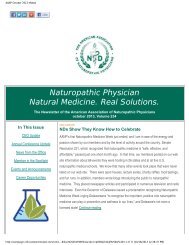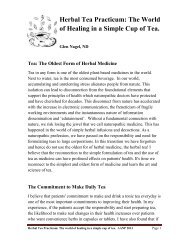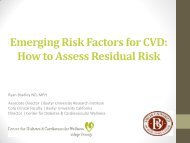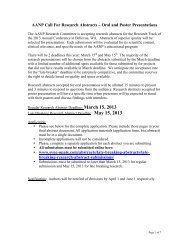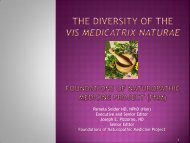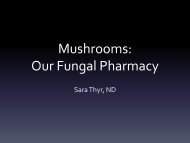Treat. The. Gut.
Treat. The. Gut.
Treat. The. Gut.
Create successful ePaper yourself
Turn your PDF publications into a flip-book with our unique Google optimized e-Paper software.
<strong>Treat</strong>.<strong>The</strong>.<strong>Gut</strong>.Addressing CDI, UC, IBS and more withFecal Microbiota Transplantation (FMT)Mark Davis, ND
<strong>Treat</strong>.<strong>The</strong>.<strong>Gut</strong>.Addressing CDI, UC, IBS and more withFecal Microbiota Transplantation (FMT)Mark Davis, ND2013 AANP convention in the licensed state of Colorado!
introduction• Mark Davis, ND• NCNM class of 2011, honors in research• Private practice, Bright Medicine Clinic: Portland, OR
introduction• Mark Davis, ND• NCNM class of 2011, honors in research• Private practice, Bright Medicine Clinic: Portland, OR• I’ve used FMT with sixty patients, about half of whom haveinflammatory bowel disease (IBD)• Remote consults with dozens more, but no doctor/patientrelationship, generally little follow-up, and no data collection
introduction• Mark Davis, ND• NCNM class of 2011, honors in research• Private practice, Bright Medicine Clinic: Portland, OR• I’ve used FMT with sixty patients, about half of whom haveinflammatory bowel disease (IBD)• Remote consults with dozens more, but no doctor/patientrelationship, generally little follow-up, and no data collection• Was only physician in North America offering donor-bank drivenFMT for conditions outside of C difficile infection (CDI)• FecalMicrobiotaTransplantation.com, probioticinfusion.com
Acknowledgements andconflict of interestThanksImages and quotesCOI
Room surveyRaise your hand if you’ve ever prepared or administeredfecal slurry for therapeutic benefit
Room surveyRaise your hand if you’ve ever prepared or administeredfecal slurry for therapeutic benefitRaise your hand if you’ve recommended FMT to apatient, referred for FMT, or walked a patient throughhow to prepare and self-administer FMT at home
Overview• Nomenclature and history• Micro/gastro review (with fun quizzes!)• Nuts and bolts of FMT• Current legal status• Cost and the yuck factor• In the literature: Safety and efficacy of FMT for CDI, IBD,IBS, and more• Case series and case
FMT, aka…
FMT, aka…Fecal transplant
FMT, aka…Fecal transplantFecal bacteriotherapy
FMT, aka…Fecal transplantFecal bacteriotherapyHuman probiotic infusion
FMT, aka…Fecal transplantFecal bacteriotherapyHuman probiotic infusionFecal slurry
FMT, aka…Fecal transplantFecal bacteriotherapyHuman probiotic infusionFecal slurry<strong>Gut</strong> flora rehabilitation
FMT, aka…Fecal transplantFecal bacteriotherapyHuman probiotic infusionFecal slurry<strong>Gut</strong> flora rehabilitationIntestinal microbiota transplantation
FMT, aka…Fecal transplantFecal bacteriotherapyHuman probiotic infusionFecal slurry<strong>Gut</strong> flora rehabilitationIntestinal microbiota transplantationFecal microbiota transplantation
HistoryGe Hong, 4th century CE
HistoryGe Hong, 4th century CEPO fecal suspension for food poisoning or severe diarrhea
HistoryGe Hong, 4th century CEPO fecal suspension for food poisoning or severe diarrheaLi Shizhen, 16th century CE
HistoryGe Hong, 4th century CEPO fecal suspension for food poisoning or severe diarrheaLi Shizhen, 16th century CEFermented, fresh, dried, or infant feces (“yellow soup” ) forsevere diarrhea, vomiting, and constipation
HistoryFabricius Aquapendente(1537-1619)Transfaunation
HistoryJournal of Advanced<strong>The</strong>rapeutics, Jan 1910
• Ben Eiseman, MDHistory
History• Ben Eiseman, MDBen Eiseman, MD
History• Ben Eiseman, MDBen Eiseman, MDWilliam Silen, MD
HistoryClostridium difficile discovered in 1935, but link betweenC diff and pseudomembranous colitis not elucidateduntil 1978.
History
History• 11 years of UC• 7 years of severe symptoms if he dropped below 30 mg/dprednisone• 3 months post-FMT no symptoms, no prednisone, colonoscopyreveals no active inflammation
History
History
History
History
History
History
History
History
Micro/gastro Review
Micro/gastro ReviewWhat percent ofa human beingconsists ofmicrobes??
Micro/gastro ReviewMicrobes make up:A. 1-3% of the total human
Micro/gastro ReviewMicrobes make up:A. 1-3% of the total humanB. 90% of the total human
Micro/gastro ReviewMicrobes make up:A. 1-3% of the total humanB. 90% of the total humanC. 99% of the total human
Micro/gastro ReviewMicrobes make up:A. 1-3% of the total humanB. 90% of the total humanC. 99% of the total humanD. All of the above
Micro/gastro ReviewIn which of the following areas do microbes live?(please cheer for microbe-containing areas as Iread them)
Micro/gastro ReviewIn which of the following areas do microbes live?<strong>The</strong> adult colon
Micro/gastro ReviewIn which of the following areas do microbes live?<strong>The</strong> adult colon<strong>The</strong> lungs
Micro/gastro ReviewIn which of the following areas do microbes live?<strong>The</strong> adult colon<strong>The</strong> lungs<strong>The</strong> bladder
Micro/gastro ReviewIn which of the following areas do microbes live?<strong>The</strong> adult colon<strong>The</strong> lungs<strong>The</strong> bladder<strong>The</strong> GI tract of a fetus
Micro/gastro ReviewIn which of the following areas do microbes live?<strong>The</strong> adult colon<strong>The</strong> lungs<strong>The</strong> bladder<strong>The</strong> GI tract of a fetus
Micro/gastro ReviewIn which of the following areas do microbes live?<strong>The</strong> adult colon<strong>The</strong> lungs<strong>The</strong> bladder<strong>The</strong> GI tract of a fetus
Micro/gastro ReviewIn which of the following areas do microbes live?<strong>The</strong> adult colon<strong>The</strong> lungs<strong>The</strong> bladder<strong>The</strong> GI tract of a fetus
<strong>The</strong> gut microbiome
<strong>The</strong> gut microbiomeConcentration of bacteria per mL:• Duodenum: 10-1,000• Jejunum & ileum: 10,000-one million• Colon: 10-100 billion
<strong>The</strong> gut microbiome
<strong>The</strong> gut microbiome
<strong>The</strong> gut microbiomePatients often report that the consistency and odor of their bowel movements becomesidentical to that of their donor.
OK, but what is it?
OK, but what is it?Fecal microbiota transplantationconsists of collecting stool from ahealthy donor, diluting, blending,and filtering it, and delivering it tothe patient, usually via enema
OK, but what is it?Fecal microbiota transplantationconsists of collecting stool from ahealthy donor, diluting, blending,and filtering it, and delivering it tothe patient, usually via enema
OK, but what is it?Fecal microbiota transplantationconsists of collecting stool from ahealthy donor, diluting, blending,and filtering it, and delivering it tothe patient, usually via enema
OK, but what is it?Fecal microbiota transplantationconsists of collecting stool from ahealthy donor, diluting, blending,and filtering it, and delivering it tothe patient, usually via enema
FMT Working GroupScreening protocolsSerologic testing• HIV 1 and 2• Rapid plasma reagin andfluorescent treponemalantibody-absorbed•Viral hepatitis panel
FMT Working GroupScreening protocolsSerologic testing• HIV 1 and 2• Rapid plasma reagin andfluorescent treponemalantibody-absorbed•Viral hepatitis panelStool testing• C difficile toxin B by PCR• Routine bacterial culture forenteric pathogens• Fecal Giardia antigen• Fecal Cryptosporidium antigen• Acid-fast stain for Cyclospora andIsospora• Microscopy for ova and parasites
FMT Working GroupScreening protocolsSerologic testing• HIV 1 and 2• Rapid plasma reagin andfluorescent treponemalantibody-absorbed•Viral hepatitis panelI add:•PCR stool screening test to look atrelative abundances of somenormal stool flora as well as screenin a more sensitive way for somepathogens or borderline pathogensStool testing• C difficile toxin B by PCR• Routine bacterial culture forenteric pathogens• Fecal Giardia antigen• Fecal Cryptosporidium antigen• Acid-fast stain for Cyclospora andIsospora• Microscopy for ova and parasites
FMT Working GroupScreening protocols• <strong>The</strong> eligible donor is a healthy individual withoutcommunicable disease or risk factors, with no history ofIBD, IBS, or GI malignancy, no antibiotic, majorimmunosuppressive or systemic antineoplastic use in thepast three months, who does not have autoimmune, atopicor chronic pain disease, food or respiratory allergies,metabolic syndrome or mood disorders, and has notrecently ingested any potential allergens.
FMT Working GroupScreening protocols• <strong>The</strong> eligible donor is a healthy individual withoutcommunicable disease or risk factors, with no history ofIBD, IBS, or GI malignancy, no antibiotic, majorimmunosuppressive or systemic antineoplastic use in thepast three months, who does not have autoimmune, atopicor chronic pain disease, food or respiratory allergies,metabolic syndrome or mood disorders, and has notrecently ingested any potential allergens.• I also consider: was the donor breastfed, vaginally delivered?Willing and able to stay well-hydrated and eat a diet rich infibrous whole foods? Has a 3-4 on the Bristol stool scale onmost days? Skin health? Mental clarity? Adult vs.pediatric? Blood type? Gender? Strong vis?
How to perform FMT:Utilize the healing power of nature
How to perform FMT:Utilize the healing power of nature<strong>Treat</strong> the cause (patient screening)
How to perform FMT:Utilize the healing power of nature<strong>Treat</strong> the cause (patient screening)Do no harm (donor screening)
How to perform FMT:
How to perform FMT:
How to perform FMT:
How to perform FMT:
How to perform FMT:
How to perform FMT:
How to perform FMT:x1
How to perform FMT:x1x10
Current legal status
Current legal status• Long history of naturopathic doctors being jailed orprosecuted for practicing ways not approved bycontemporary legislators.
Current legal status• Long history of naturopathic doctors being jailed orprosecuted for practicing ways not approved bycontemporary legislators.• FMT had long been in legislative limbo
Current legal status• Long history of naturopathic doctors being jailed orprosecuted for practicing ways not approved bycontemporary legislators.• FMT had long been in legislative limbo• Different legal opinions:
Current legal status• “Since the FDA regulates interstate commerce inmedicine, if you’re using stool from Oregon anddiluent from Oregon, I don’t really see how it’s theFDA’s business what you do.”
Current legal status• “You really don’t want to get in a pissing match withthe FDA.”
Current legal status• “You really don’t want to get in a pissing match withthe FDA.”
Current legal status• “You really don’t want to get in a pissing match withthe FDA.”
Current legal status• “You really don’t want to get in a pissing match withthe FDA.”Conversations around FMT?
Current legal status• “You really don’t want to get in a pissing match withthe FDA.”Conversations around FMT?“<strong>The</strong> FDA is allowing it’s regulatory policies toevolve”
Current legal status“<strong>The</strong> FDA is allowing it’s regulatory policies toevolve”
Current legal status“<strong>The</strong> FDA is allowing it’s regulatory policies toevolve”
Current legal status“<strong>The</strong> FDA is allowing it’s regulatory policies toevolve”
Current legal status
Current legal status
Cost• Centre for Digestive Diseases: US patients estimatespending $10,000-$20,000 counting travel and lodging costs(10 days?)• Rogue Valley: $2,000 + donor screening (single infusion)• Bright Medicine: $800 donor screening fee plus $400 perpreparation & administration ($1200 for a single infusion)• DIY with a trusted, symptom-free related donor (e.g. a childor parent): $2 for an enema bag, plus $15 for a blender ($17for a single infusion).
<strong>The</strong> “yuck” factor• Not so yucky after all:• Khan SA, Gorawara-Bhat R, Rubin D. Fecalbacteriotherapy forulcerative colitis:patients are ready, arewe? Inflamm BowelDis 2011
Causes of CDI, IBD, IBS
Causes of CDI, IBD, IBS
FMT for CDI• CDI is Clostridium difficile infection: spore former,commonly overgrows after clindamycin, penicillin,floroquinalones, cephalosporins
FMT for CDI• CDI is Clostridium difficile infection: spore former,commonly overgrows after clindamycin, penicillin,floroquinalones, cephalosporins• Detected using PCR for toxin B
FMT for CDI• CDI is Clostridium difficile infection: spore former,commonly overgrows after clindamycin, penicillin,floroquinalones, cephalosporins• Detected using PCR for toxin B• Detected in 0.26% of hospitalized patients in 1993,and 0.54% of hospitalized patients in 2003
FMT for CDI• CDI is Clostridium difficile infection: spore former,commonly overgrows after clindamycin, penicillin,floroquinalones, cephalosporins• Detected using PCR for toxin B• Detected in 0.26% of hospitalized patients in 1993,and 0.54% of hospitalized patients in 2003• In 2010, the annual incidence of CDI was estimated at500,000 and mortality at 15,000–20,000
FMT for CDI• Conventional Rx:• Vancocin (or compounded vancomycin, FDA approvedtreatment): 85-96% effective, 20-25%% recurrence. (31% relapsewith tapered, 14% with pulsed) Takes 3-8 days. Small caseseries: 8/9 cases cured with enema delivery.• Metronidazole: 74-87% effective, 20-30% recurrence ratewithin 60 days. Takes 8-16 days to work. Long courses canlead to neuropathies.• Rifaximin, nitazoxinide may help.• Dificid (fidaxomicin): FDA approved in May 2011.• 85% effective, 15% relapse• Sach boulardii decreases relapse rate if given with >2gvancomycin, caution with fungemia in immunosuppressedpatients.
FMT for CDI• Conventional Rx:• Vancocin (or compounded vancomycin, FDA approvedtreatment): 85-96% effective, 20-25%% recurrence. (31% relapsewith tapered, 14% with pulsed) Takes 3-8 days. Small caseseries: 8/9 cases cured with enema delivery.• Metronidazole: 74-87% effective, 20-30% recurrence ratewithin 60 days. Takes 8-16 days to work. Long courses canlead to neuropathies.• Rifaximin, nitazoxinide may help.• Dificid (fidaxomicin): FDA approved in May 2011.• 85% effective, 15% relapse• Sach boulardii decreases relapse rate if given with >2gvancomycin, caution with fungemia in immunosuppressedpatients.
FMT for CDI• Up to 65% of patients who have experienced onerecurrence will experience another
FMT for CDI• Up to 65% of patients who have experienced onerecurrence will experience another• About 1/3 of recurrences are new strain
FMT for CDI• Up to 65% of patients who have experienced onerecurrence will experience another• About 1/3 of recurrences are new strain• If resistant to all antibiotics, colectomy (0.25-1% ofpatients with C diff diagnosis)
FMT for CDI• Up to 65% of patients who have experienced onerecurrence will experience another• About 1/3 of recurrences are new strain• If resistant to all antibiotics, colectomy (0.25-1% ofpatients with C diff diagnosis)• CDI was 7.8% fatal in 1993, 9.3% fatal in 2003
FMT for CDI• Up to 65% of patients who have experienced onerecurrence will experience another.• About 1/3 of recurrences are new strain.• If resistant to all antibiotics, colectomy (0.25-1% ofpatients with C diff diagnosis).• CDI was 7.8% fatal in 1993, 9.3% fatal in 2003.
FMT for CDI
FMT for CDI
• 92% successfulFMT for CDI
FMT for CDI• 92% successful• <strong>The</strong>rapeutic response in hours to days
FMT for CDI• 92% successful• <strong>The</strong>rapeutic response in hours to days• If delivered by enema, only noted S/E is transientabdominal tenderness
FMT for CDI• 92% successful• <strong>The</strong>rapeutic response in hours to days• If delivered by enema, only noted S/E is transientabdominal tenderness• If delivered via colonoscope, could include perforation,risks of anesthesia
FMT for CDI
FMT for CDI• Reviewed 317 patients treated for CDI with FMT
FMT for CDI• Reviewed 317 patients treated for CDI with FMT• 92% experienced resolution, 4% relapse rate.
FMT for CDIBest guesses for best care:Up to 3 infusions (96% effective)vs.1 infusion (88%)
FMT for CDIBest guesses for best care:Enema or rectal catheter delivery (95% effective)vs.colonoscopic (88%)
FMT for CDIBest guesses for best care:Related donor, counting spouses (93% effective)vs.unrelated (84%) or mixed (79%)
FMT for CDIBest guesses for best care:Water as diluent (95% effective)vs.N saline (86%)
FMT for CDIBest guesses for best care:>500 mL suspension (97% effective)vs.200-500 mL (86%)or
FMT for CDI
FMT for CDI
FMT for CDI
FMT for CDI
FMT for CDIMy limited results: less durable
FMT for CDIQuestions about FMT for CDI?
FMT for IBD and IBS
FMT for IBD and IBS
FMT for IBD and IBS
FMT for IBD and IBS
FMT for IBD and IBS
FMT for IBD and IBS
FMT for IBD and IBS
FMT for IBD and IBS
FMT for IBD and IBS
FMT for IBD and IBS
FMT for IBD and IBSQuestions about FMT for IBD andIBS?
FMT for otherconditions
FMT for otherconditions
FMT for otherconditions
FMT for otherconditions
FMT for otherconditions
FMT for otherconditions
FMT for otherconditions
Case series
Case series
Case series
Case #1• 51yo M with 36y hx of IBD sxs, UC dx for 15y
Case #1• 51yo M with 36y hx of IBD sxs, UC dx for 15y• Managed on asacol 1600 mg qid, 6mp 50mg/d,remicade q 6 weeks, cortenema 2-3x/week
Case #1• 49yo M with 34y hx of IBD sxs, UC dx for 13y• Managed on asacol 1600 mg qid, 6mp 50mg/d,remicade q 6 weeks, cortenema 2-3x/week• 3-4 urgent BMs/d, no blood or mucous as long as heavoids certain fiber foods (esp lettuce)
Case #1• 49yo M with 34y hx of IBD sxs, UC dx for 13y• Managed on asacol 1600 mg qid, 6mp 50mg/d,remicade q 6 weeks, cortenema 2-3x/week• 3-4 urgent BMs/d, no blood or mucous as long as heavoids certain fiber foods (esp lettuce)• Colonoscopy 5 months previous reveals L sided colitis
Case #1
Case #1• Daily fecal slurry retention enemas, M-F x 3 weeks
Case #1• Daily fecal slurry retention enemas, M-F x 3 weeks• Followed by 1-2x/week for 4 weeks
Case #1• Daily fecal slurry retention enemas, M-F x 3 weeks• Followed by 1-2x/week for 4 weeks• Moved from 3-4 BM/d to 1-2, D/C’d hydrocortisoneenemas
Case #1• Daily fecal slurry retention enemas, M-F x 3 weeks• Followed by 1-2x/week for 4 weeks• Moved from 3-4 BM/d to 1-2, D/C’d hydrocortisoneenemas• Challenged with lettuce:
Case #1• Daily fecal slurry retention enemas, M-F x 3 weeks• Followed by 1-2x/week for 4 weeks• Moved from 3-4 BM/d to 1-2, D/C’d hydrocortisoneenemas• Challenged with lettuce: blood/mucus in stool
Case #1• Vancomycin 500 mg bid, metronidazole 500 mg bid,rifampicin 150 mg bid, all po x 7
Case #1• Vancomycin 500 mg bid, metronidazole 500 mg bid,rifampicin 150 mg bid, all po x 7• Oral lacto/bifido probiotic 50b CFU/d x 7d
Case #1• Vancomycin 500 mg bid, metronidazole 500 mg bid,rifampicin 150 mg bid, all po x 7• Oral lacto/bifido probiotic 50b CFU/d x 7• Interphase (+) 2 caps bid x 7d
Case #1• Vancomycin 500 mg bid, metronidazole 500 mg bid,rifampicin 150 mg bid, all po x 7• Oral lacto/bifido probiotic 50b CFU/d x 7• Interphase (+) 2 caps bid x 7d• 10 mg prednisone taper c 50 mg DHEA
Case #1• Vancomycin 500 mg bid, metronidazole 500 mg bid,rifampicin 150 mg bid, all po x 7• Oral lacto/bifido probiotic 50b CFU/d x 7• Interphase (+) 2 caps bid x 7d• 10 mg prednisone taper c 50 mg DHEA• Day 8: PEG bowel lavage, only H2O po
Case #1• Daily fecal slurry retention enemas, M-F x 3 weeks• Followed by 1-2x/week for (6?) weeks
Case #1• Daily fecal slurry retention enemas, M-F x 3 weeks• Followed by 1-2x/week for (6?) weeks• No blood, no mucus, 1-2 formed BM/d
Case #1• Daily fecal slurry retention enemas, M-F x 3 weeks• Followed by 1-2x/week for (6?) weeks• No blood, no mucus, 1-2 formed BM/d• Gradually D/C’d all meds, remained aymptomatic
Case #1• Daily fecal slurry retention enemas, M-F x 3 weeks• Followed by 1-2x/week for (6?) weeks• No blood, no mucus, 1-2 formed BM/d• Gradually D/C’d all meds, remained aymptomatic• Lettuce challenge:
Case #1• Daily fecal slurry retention enemas, M-F x 3 weeks• Followed by 1-2x/week for (6?) weeks• No blood, no mucus, 1-2 formed BM/d• Gradually D/C’d all meds, remained aymptomatic• Lettuce challenge: no symptoms!
Case #1• Daily fecal slurry retention enemas, M-F x 3 weeks• Followed by 1-2x/week for (6?) weeks• No blood, no mucus, 1-2 formed BM/d• Gradually D/C’d all meds, remained aymptomatic• Lettuce challenge: no symptoms!• 14 months aymptomatic with no meds, varied diet
Case #2• Warning: graphic images including stool and blood
Case #2• 22-month-old M with six month history of blood instool leading to hospitalization and diagnosis ofulcerative pancolitis three months previously (& VRE)
Case #2• 22-month-old M with six month history of blood instool leading to hospitalization and diagnosis ofulcerative pancolitis three months previously (& VRE)• 5 (+?) blood transfusions in previous three months, anda couple weeks of parenteral nutrition
Case #2• 22-month-old M with six month history of blood instool leading to hospitalization and diagnosis ofulcerative pancolitis three months previously (& VRE)• 5 (+?) blood transfusions in previous three months, anda couple weeks of parenteral nutrition• Prednisone taper (currently 7.5 mg), low fiber diet,Sach boulardii bid, iron suppls
Case #2• 22-month-old M with six month history of blood instool leading to hospitalization and diagnosis ofulcerative pancolitis three months previously (& VRE)• 5 (+?) blood transfusions in previous three months, anda couple weeks of parenteral nutrition• Prednisone taper (currently 7.5 mg), low fiber diet,Sach boulardii bid, iron suppls• 5-10 bloody BMs/d, three diaper changes during ourfirst (1h) office visit:
Case #2
Case #2
Case #2
• Day 1, sample diaper:Case #2
Case #2• Day 1, sample diaper:• Eve 1, 80 mL night-time infusion
Case #2• Days 2-6, gradual decrease in frequency, bleeding
Case #2• Days 2-6, gradual decrease in frequency, bleeding• Day 7, first day of no blood, formed stool
Case #2• Days 2-6, gradual decrease in frequency, bleeding• Day 7, first day of no blood, formed stool• Day 8, only 2 BMs, small amount blood in one
Case #2• Days 2-6, gradual decrease in frequency, bleeding• Day 7, first day of no blood, formed stool• Day 8, only 2 BMs, small amount blood in one• Days 9-10, no blood, formed stool**This is ten consecutive infusions, and I instruct movingto q other day evening infusions
Case #2• Days 2-6, gradual decrease in frequency, bleeding• Day 7, first day of no blood, formed stool• Day 8, only 2 BMs, small amount blood in one• Days 9-10, no blood, formed stool**This is ten consecutive infusions, and I instruct movingto q other day evening infusions• Day 11, mom frustrated with mood swings, stopsprednisone 3 days early (skips infusion)
• Day 12 sample diaper:Case #2
Case #2• Day 12 sample diaper:(cold or flu in household?)(evening FMT infusion)
Case #2• Day 12 sample diaper:(cold or flu in household?)(evening FMT infusion)• Day 13 sample diaper:(Mom has cold, no FMT)
Case #2• Over the next week, no FMT and patient starts todecline
Case #2• Over the next week, no FMT and patient starts todecline• Emergent care, infliximab started. Pediatric gastroasks for no outside interventions during this time
Case #2• Over the next week, no FMT and patient starts todecline• Emergent care, infliximab started. Pediatric gastroasks for no outside interventions during this time• Infliximab q 6 weeks, breakthrough sx in 2 weeks preinfliximabover the course of three rounds (4 months)
Case #2• Over the next week, no FMT and patient starts todecline• Emergent care, infliximab started. Pediatric gastroasks for no outside interventions during this time• Infliximab q 6 weeks, breakthrough sx in 2 weeks preinfliximabover the course of three rounds (4 months)• Evening FMT infusions q 2 nights for one month—nobreakthrough symptoms
Case #2• Currently still on infliximab q 8 weeks withoutbreakthrough symptoms
Case #3• 30yo F with ulcerative proctitis (20 cm from rectum) x6 months
Case #3• 30yo F with ulcerative proctitis (20 cm from rectum) x6 months• Well-managed on curcumin 1 g bid, boswellia 1g/d,fish oil (8-10 g/d EPA/DHA), lacto/bifido probiotic4b CFUs/d
Case #3• 30yo F with ulcerative proctitis (20 cm from rectum) x6 months• Well-managed on curcumin 1 g bid, boswellia 1g/d,fish oil (8-10 g/d EPA/DHA), lacto/bifido probiotic4b CFUs/d• S boulardii and LDN added after three months, addedbenefit for atopic derm
Case #3• 30yo F with ulcerative proctitis (20 cm from rectum) x6 months• Well-managed on curcumin 1 g bid, boswellia 1g/d,fish oil (8-10 g/d EPA/DHA), lacto/bifido probiotic4b CFUs/d• S boulardii and LDN added after three months, addedbenefit for atopic derm• Mesalamine enemas added after another three monthsduring stress of family travel
Case #3• Another three months, UP flare not responsive to anyof above therapies or dietary restrictions
Case #3• Another three months, UP flare not responsive to anyof above therapies or dietary restrictions• Emotionally unable to complete 24-hour water fast
Case #3• Another three months, UP flare not responsive to anyof above therapies or dietary restrictions• Emotionally unable to complete 24-hour water fast• 10 FMT home infusions with child donor: no benefit
Case #3• Another three months, UP flare not responsive to anyof above therapies or dietary restrictions• Emotionally unable to complete 24-hour water fast• 10 FMT home infusions with child donor: no benefit• 3 months later, still not well-managed, another 10infusions from different donor: seems to be improvingsxs during the 10 days—acute rhinosinusitis on day 10,flares UC, no durable benefit apparent from FMT
Case #3• Another three months, UP flare not responsive to anyof above therapies or dietary restrictions• Emotionally unable to complete 24-hour water fast• 10 FMT home infusions with child donor: no benefit• 3 months later, still not well-managed, another 10infusions from different donor: seems to be improvingsxs during the 10 days—acute rhinosinusitis on day 10,flares UC, no durable benefit apparent from FMT
Troubleshooting• Viscosity• Enema tubing• Stopping meds• Donor issues• Oral lab-cultured probiotics?• FMT-refractory/relapsing cases—biofilms? MAP?
Q & Amark@brightmedicineclinic.com



